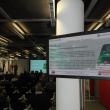- 09-10.10.2014. 18th International Waste Recycling Conference
- 10.04.2014. The Admine consortium submitted its proposal for the Horizon2020 call
The consortium, which is coordinated by Geonardo, has 11 members. The University of Miskolc is represented by the team of the Earth Science Engineering Faculty. The proposal has been submitted to the EU for the 8April deadline. The work is aimed at elaborating legal framework to protect and develop mineral deposits of public importance. The 30 month long project will be completed by partners from Hungary, UK, Portugal, Romania, Sweden, EU/Brussels.
14.04.2014.
János Földessy
- 14.03.2014. Criticel news in the GEODA magazine - 17 new species in the list of Hungarian minerals
In the Criticel research programs through 2013 seventeen new minerals have been identified in HUngarian mineral occurrences, mainly REE minerals from the Mecsek phonolites. Several of them are rarities even on international level. Also new minerals were identified in the Pátka- Szúzvár fluorite veins paragenesis, like aikinite-bizmutine Cu-Pb-Bi-sulfosalts.
14.03.2014.
Sándor Szakáll
- 23.02.2014. ME MFK Faculty as member in the ADMINE proposal in the H2020
Geonardo, our cooperating partner has invited the Faculty to become full member of the ADMINE consortium. The partners prepare project proposal in the topic of Mineral deposits of public importance in the H2020 calls by the April8 deadline. The consortium has 14 different partners at present, from several countries and EU organizations.
- 20-21.02.2014. La Palma Research Center visit our University
La Palma Research Centre for Future Studies of Spain and University of Miskolc, Faculty of Earth Science and Engineering has long time good relation according to previous joint FP5/FP6 and FP7 project works. At 21st – 20th February, 2014, colleagues of the research centre has visited our university and met representatives of Faculty of Earth Sciences, Faculty of Material Engineering, European Federation of Geologist and also both large basic research project „CriticEL” and „Kútfő”. An intensive H2020 project preparation work has been carried out at the workshop.
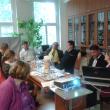

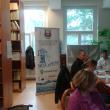
- 20.01.14. CRITICEL studies in the BKL-Mining Journal
The BKL Mining Journal has dedicated its 2013/5-6 issue wholly to the publication of the results of the CRITICEL programs, i.e. mineral raw materials and processing technologies . The papers, which cover a broad range various topics from REE occurrences to glass-sand waste heavy fraction recovery - are in Hungarian language with English abstract, downloadable from the BKL homepage.
20.01.2014.
János Földessy
BKL Mining Journal, publication, mineral raw materials, processing technologies
- 13.01.14 Value from wastes - research for secondary raw materials
There are basically two main possibilities for recovery of critical raw materials (CRM) in Hungary:1. Mining and processing of ore,- mineral and coal mining tailings, fly ashes and metallurgic process of CRM bearing concentrates.Within the frame of this subproject, tailings from Fehérvércsurgó glass sand ; fluorite – polymetallic ore tailing from Pátka and manganese ore tailing from Úrkút are involved. Process engineering technical aspects are studied using physical (based on magnetic, electric properties or based on different specific gravity), physic-chemical and chemical separation methods.2. Recovery of CRM from construction materials of end of lifetime electric and electronic devices produced for industrial and household use.WEEE, like scrap notebooks, mobile phones, display panels(PDP, LCD, LED-LCD) and PCB’s Critical elements contain high concentrations of Sb, Be, Co, F, Ga, Ge, Ta, W, In, Nb, Mg, REE, PGE with precious (Au, Ag, Pt) and base metals (Cu, Pb, Sn, Zn, Al). Base metal bearing parts are separated by mechanical separation technologies based on specific gravity, magnetic and electric properties can be used for their recovery after a proper comminution stage of the raw material. CRM elements and precious metals however can be found often in very fine particles or as alloys, therefore recovery of them can be done only using chemical or biological extraction and separation.Institute of Raw Materials Preparation and Process Engineering, Institute of Mineralogy and Geology of Miskolc University are the main partners in the realization of the subproject. Analytical measurements are carried out by Hungarian Scientific Academy, Research Centre for Natural Sciences13.01.2014.Barnabás Csőke, secondary raw materials
- 12.01.2014. Surface geophysics in discovering ore enrichments
Surface geophysics are non-destructive physical methods applied for mineral exploration. The presence of an ore-body may be concluded from the subsurface distributions of the different physical parameters, as determined by the inversion of the observed geophysical data. In the course of the project we made geophysical measurements in the vicinity of Bükkszentkereszt and Irota and interpreted the geophysical data of Pátka-Szűzvár area. Important beryllium (Be) indications are known in Bükkszentkereszt. Complex geophysical (magnetic, very low frequency electromagnetic, spectral radiometry, multielectrode resistivity and induced polarization) measurements were made to gain more knowledge about the host rock of Be ores. It was observed that these ore zones were overlain by mainly high resistivity and low chargeability metavolcanics. For further exploration, the simultaneous application of resistivity and induced polarization measurements can be suggested. In the figure, the geophysical interpretation of the measured apparent resistivity (A) and apparent chargeability (B) along the same profile can be seen. On the right part of the section the effect of separated limestone blocks embedded in clay, in the middle a high resistivity and low chargeability zone of the inhomogeneous metavolcanic bedrock in uplifted situation and on the left from a fault the effect of the gradually ascending metavolcanics, finally appearing on the surface, can be observed.
12.01.2014.
Endre Turai, Beryllium, Bükkszentkereszt
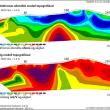
- 11.01.2014. Unexpected cobaltite finding in a Darnó borehole
During our search for PGE minerals, in a basalt sample from the drillhole Rm 135, 543.6 m cobaltite (CoAsS) was found by ore microscopic and microprobe analyses. Until now, this mineral has not been mentioned in this area. The cobaltite forms tiny, 5-10 µm large, angular crystals in another ore mineral, the chalcopyrite (CuFeS2). At the moment, the cobaltite is still a curiosity, significant cobalt enrichment is not known.11.01.2014.Éva HartaiCobalt, Recsk, Darnó
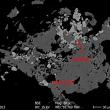
- 10.01.2014 PGE enrichments in Hungarian geological formations?
Module leader: Dr. Éva Hartai, senior lecturer, foldshe@uni-miskolc.hu
Are there any PGE enrichments in Hungary? Our research aims to reveal their occurrence and potential grade of enrichment. First we collected all relevant data from the Hungarian archives and summarized the results in the first volume of the monographs in the CriticEl project.
According our research plan the following formations have PGE potential: (1) the Recsk ore complex; (2) Jurassic igneous rocks of the Szarvaskő unit; (3) Triassic volcanics of the Darnó Complex; (4) mafic and ultramafic igneous bodies in deep boreholes in other areas..The field work has already been carried out and the available drilling samples were also collected along with the preparation of the samples. Recently the ore microscopic, microprobe and X-ray diffraction analysis, as well as the chemical analysis by ICP -AES method is in progress. Based on the results a summary evaluation will be carried out. In the sustainment of the project, further research efforts will be paid on the promising areas.10.01.2014.Éva HartaiPGE, platina, Recsk, Irota, Szarvaskő, Darnó - 17th Conference on Waste Recycling- 21-22. November,2013
Waste Recycling conference was organised 17th times in Kosice, Slovakia by the Institute of Geotechnics Slovak Academy of Science. Within the frame of the conference presentations were held in topics of waste recycling by delegations from Poland, Finland, Slovak Republic, Czech Republic and Hungary. Results of CriticEl program were also presented by young researchers and PhD students. Next conference will be held in Miskolc at University of Miskolc
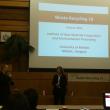
- CriticEl article has been published in Croatia-16.11.2013.
Gabriella Kiss (ELTE) and Federice Zaccarini (U Leoben) are the co-authors of the article published in the Geologica Croatica (IF2012:0,511) about the ore mineralogy of the Tapolcsany Formation limestones in the DDH Rm135 at the Darno Hill. The work has been prepared in the course of the Criticel project,m and contributes significantly to the knowledge of the Tapolcsany Formation and the hosted stratiform base metal mineralizaton and other critical elements. The study can be downloaded by clicking here.
http://www.geologia-croatica.hr/ojs/index.php/GC/article/view/GC.2013.19
- YOUNG RESEARCHERS PARTICIPATE ON THE PETROLOGY AND GEOCHEMISTRY WORKSHOP IN ORFŰ
On September 14, 2013 several young researchers attend on the Workshop of Petrology and Geochemistry in Orfű, and present the preliminary results of the Criticel projects. Reka Horvath (in cooperation with Wildhorse Energy geologists) introduces a poster about the geochemical characteristics of the Mecsek coals. Anita Gerges and co-authors from thhe Rotaqua Ltd discuss the distribution of gold in the Rudabanya ore complex. Attila Horvath and Istvan Hajdú also participate in the meeting by presenting lecture and poster about their research.
- CRITICEL SCIENTIST ON THE 25 HOTTEST ARTICLES LIST OF THE SCIENCE DIRECT
Dr Ferenc Kristály is one of the co-authors (along with Romanian and British scientists) of a study dealing with forsterite nanopowder, which has been published in the Journal of Materials Science & Technology (IF2012:1,18) and reached the 25 hottest article list in the Materials Science category of the Science Direct in April-June 2013. Congratulations!
Click: http://top25.sciencedirect.com/subject/materials-science/15/journal/journal-of-materials-science-technology/10050302/archive/45 - OUR SCIENTISTS ON THE SOMP ANNUAL MEETING
Between 26 June and 29 June Ákos Debreczeni Associate Professor, János Földessy Professor, and Ferenc Kovács, Member of HAS, have participated on the SOMP (Society of Mining Professors) annual meeting at Milos/Greece. On the conference 58 participants from 20 countries have attended. Janos Foldessy has given presentation about the CRITICEL projekt. Several participants have expressed their interest in joint research within the frame of CRITICEL. The island is a growing tourist place, with 2 million tonnes per annum mining production, exemplifying the peaceful co-existence of two such diverse segments of the economy. The CRITICEL presentation can be downloaded here.
- GERMAN PROFESSOR'S SHORT COURSE FOR THE CRITICEL SCIENTISTS
On June 26-27 Prof. Dr. habil. Harald G. Dill, (BGR Hannover, Germany, Leibnitz Universität Hannover, Johannes Gutenberg Universität Mainz) has held a two-day short course in the University of Miskolc upon the invitation of the CRITICEL project, with the title of „Economic geology of strategic elements, with special focus on the Hungarian mineralizations".The professor is world known researcher of ineral deposits. His famous publicatioon “The “chessboard” classification scheme of mineral deposits: Mineralogy and geology from aluminum to zirconium” appears on the Science Direct „Top 25 Hottest Articles” list and ranks as 1st according to citations in the Earth Science Reviews.His program was jointly organized by the CRITICEL project (ME), the Department X of the HAS, and the Hungarian Geological Society.Apart from the CRITICEL staff, lectureres, researchers and students from Budapest, Cluj universities have also participated. Az előadásokon a projekt helyi szakemberei mellett budapesti, kolozsvári kollégák, hallgatók is résztvettek. The lecture materials can be downloaded from the following link.
2013.07.05
Hartai Éva
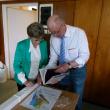
- news and events
News, Events
March, 2013: CriticEl project has announced ENCRITICEL Horizon2020 project idea.
ENCRITICEl project idea was announced in Düssledorf, Successful R&I in Europe: 5th European Networking Event" organised by NRW.Europa - An Enterprise Europe Network Partner
Energy mineral exploration and critical elements as by-products ENCRITICEL
There is a growing tendency in several countries to utilize coal resources on a wider basis as replacement of the shrinking potential for imported natural gas. Several minerals and chemical elements are mobilized during these technologies which may as well be utilized as by-products of the energy production. These are germanium and beryllium, which also appear on the criticality list of the EU. An ongoing Hungarian EU co-financed basic research project aims at identifying these potential enrichments in Hungarian mineral resources by combining geological knowledge and processing technology innovation. The proposed follow-up project would scale up the positive achievements of the basic research onto demonstration level on coal occurrences.
Partner Search:
Research Organizations and Universities in the field of geology, mining, mineral processing and metallurgy
NGOs in the area of legislation related offices and owner of databases
SMEs can be plant owner or machine producer fit to the topic, or end user of coal based raw materials
If you are interested, contact us at: criticel@uni-miskolc.hu
